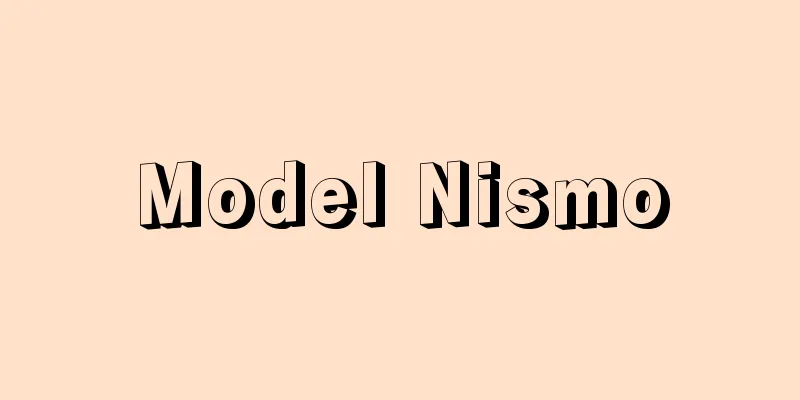Death

|
It is a concept that is contrasted with life or vitality, and can be viewed from various angles, including medicine, biology, philosophy, religion, law, and psychology. Medical/biological deathMedically, and especially clinically, death is considered to occur when the heartbeat, breathing, and brain function have clearly ceased permanently, and this is generally the most consistent criterion for determining human death. On the other hand, with the advancement of medical technology, the number of cases where patients with no hope of recovery of brain function can be mechanically maintained by attaching them to a ventilator has increased, and a new concept and criterion for determining death, known as "brain death," has been presented. However, these are clinical ways of thinking about human death, among individual deaths, and although they may be applicable to some extent to the deaths of other higher animals, they do not apply to all living things. Therefore, the medical determination of human death and forensic regulations after death will be discussed in detail in the "Death" section. In biology, death refers to a state in which an organism has irreversibly lost its life. Generally, it means the death of an individual, but the word death is also used at the level of organs, tissues, cells, etc. The standard of life and death when saying "an individual is alive" or "a cell is alive" is whether or not it has the value of existence normally expected at each level, or whether or not it performs a certain function. For example, when bacteria are recognized as alive, it means that they can divide and grow, and when they lose their ability to reproduce due to disinfectants or ultraviolet light exposure, they die even if the individual bacteria do not stop metabolizing. In higher animals, if they lose their ability to reproduce but their nervous functions and other organ activity do not stop, the individual is still alive, and the standard of life and death differs depending on the type of organism. Therefore, biological death is based on the standard of value judgment at various levels, from individuals to cells, or the definition of vitality, and if this is conceptualized, it forms the expression "irreversible loss of it". If the concept of life changes with the progress of biology, it can be said that the concept of biological death will inevitably change as well. In higher animals, when all brain activity, heartbeat, and breathing cease, and all efforts at artificial resuscitation are ineffective, death is definitely determined. This is because the value of existence expected of higher animals, mainly the integrity of the individual, is irreversibly lost. However, individual cells, tissues, and organs can continue to live if cultured or transplanted into other individuals. Although these live at the organ, tissue, and cellular level, there are no known cases of them giving rise to an individual (in higher plants, plant bodies are produced from cuttings). In lower animals, as in the case of hydra and sponges, even if the cells that make up an individual are dissociated, a new individual can be produced from the aggregated cell mass. In this experiment, the original individual certainly disappeared, but the cells survived and gave rise to a new individual. For these animals, the life and death of cells is important, and as long as the cells are alive, biological value is maintained. In other words, in lower animals, the distinction between life and death at the cellular level and life and death at the individual level is not as clear as in higher animals. On the other hand, in the case of unicellular organisms whose bodies are made up of a single cell, such as Paramecium and Chlorella, the death of the cell is equivalent to the death of the individual. [Masayoshi Furukawa and Seiichiro Kawashima] Awareness of the fact of deathEven though medical science has advanced and the average lifespan has increased, humans will inevitably die. However, we cannot directly experience our own death. We can only indirectly consider death through the phenomenon of the death of others. Not only can we not escape death, but no one knows when it will come, and since no one has ever returned from the journey to the afterlife, it is completely unknown what lies beyond death. In this sense, death remains a mystery to the living. Moreover, because humans have a strong attachment to wanting to live forever, death is still a fact filled with anxiety, fear, and sorrow. Thus, death has been recognized as something that is of great significance to people in all times and countries, not just as a medical or biological issue, but also as a philosophical and religious issue. [Fujita Tomio] Subjective meaning of deathSince death is the negation of life and the reverse of life, asking about the meaning of death is the same as asking about the meaning of life, and the fact that death has not yet come means that death is possible at any moment, so the more we become aware of the fact of death, the more we are forced to reflect on the meaning of life and subjectively question our true selves and the purpose of our lives. Therefore, by understanding and assigning meaning to life and death in a holistic and unified manner, we can give death a deeper meaning and give life a more fulfilling content. This is why thoughts about life and death are always understood as one and the same, as an inseparable "view of life and death." [Fujita Tomio] Four types of views on life and deathThe human desire to transcend death and continue living forever has given rise to the idea of solving the problem of death in terms of time. This can be categorized as follows: (1) The type that believes that actual physical life continues forever. This type is typified by the Chinese Taoist theory that taking the elixir of eternal youth and longevity will make one immortal. The Egyptian idea of preserving mummies and the Christian idea of the end of the world, in which one will be resurrected from the grave on the Day of Judgment and gain eternal physical life, are also examples of this type. Even today, there are many people who believe that they can become younger by regularly taking hormone drugs, that expensive cosmetics can help them maintain their youth and beauty, and there are many sick people who believe that they will not die just yet if they take medicines or injections. (2) The type that believes that the soul is immortal even after the body perishes. Representative examples of this type of view of the afterlife include the Buddhist Western Pure Land and the Christian concept of heaven and hell, which are accompanied by the idea of the judgment of the dead. In addition to this, there is also the idea of rebirth and transmigration, which says that humans are reborn and die in various forms. If the soul is immortal, then death is a new beginning to eternal life. Various doctrines and ways of life arise from this type, such as the idea that one should perform good deeds in this life even if it means suffering in order to obtain a passport to happiness in the afterlife, that the real hell should be transformed into an ideal heaven, or that heaven should be sought within the heart. (3) Although both the body and the soul are perishable, this type of person tries to make themselves immortal by devoting themselves to an immortal object instead. On occasions such as Higan, Obon, and All Souls' Day, many people feel deeply the long history behind their lives that they had forgotten in the rush of daily life. By tracing their lineage from parents, grandparents, and great-grandparents, and finally realizing that they are only one link in an infinite chain in which life has been passed down from ancient ancestors that cannot be traced back, they come to the realization that as long as this infinite life is immortal, they too are immortal. Ancestor worship is a good example of this. Researchers, businessmen, and fierce employees all belong to this type, believing that as long as the objects they devote their energy to, such as science, art, the ideals of human happiness and peace, and even their daily work and business, are eternal, as in "life is short and art is long," they too are immortal. (4) The type in which the body, soul, and all substitutes for them disappear, but by concentrating on one's current actions, one attains a state beyond life and death. A good example of this is the state of Zen enlightenment, a mystical experience of becoming one with God. Many people reach a state of mind without thoughts or feelings, forgetting themselves and the world around them, in a timeless moment by devoting themselves to the arts or by repeatedly practicing sports until they get bloody. They accept reality, including their attachment to life, as it is, but give new meaning to their daily lives. [Fujita Tomio] The changing meaning of deathNo matter what view one has on life and death, humans will inevitably die, and so even when the final moment comes and the central figure takes his last breath, the survivors, whether joyful or sad, remember their connection with the dead, and so funeral rites and annual memorial services are held. The format has remained almost unchanged since ancient times, but their meaning has changed. The origin of the grave is placing a stone on the corpse to restrict the activity of the spirits of the dead, but nowadays gravestones are more of an expression of remembrance and reverence for the dead. For modern people, the emphasis has shifted from the raw fear of death to how to make their actual lives richer, more enjoyable, and more fulfilling. Because death is subjectively assigned meaning in this way, it is certain that the meaning of death will continue to change in the future. [Fujita Tomio] Interpretations of Death in Various Ethnic GroupsDeath is a serious issue for humans in any society, but how death is perceived and specifically how it is dealt with differs depending on the society and culture. One of the roles of religion is to answer the meaning of death and why people die. Hinduism explains that death occurs through reincarnation. The origin of death is often explained by myths, which say that humans once had eternal life but began to die for some reason, such as when humans broke a taboo or when a god became angry and cursed them. In the mythology of the Alfurs of Celebes, God dropped stones and bananas from the sky as food for humans on earth, but humans chose bananas. In Brazil, the Apinayes say that humans responded to the calls of rocks and aloeira trees as well as rotten trees, which is why life became finite. In Melanesia and Africa, there are myths that say that this is because the message of the gods was misinterpreted. For example, in the myth of the San people, a hunter-gatherer people in Africa, the moon commands a rabbit to tell humans that "just as the moon (the moon) dies and comes back to life again, humans will die and come back to life again," but the rabbit mistakenly says that "when humans die, they will not come back to life again." In many primitive societies, the cause of individual deaths is attributed to the supernatural. For example, one study of the Chewa people of Africa found that of 149 deaths during the study, four were attributed to the work of gods (which they said were natural deaths), 140 were attributed to sorcery such as magic, and five were attributed to ancestral spirits. Thus, the cause of death is often sought in gods, spirits, witchcraft or sorcery. The Nuer people, a Nilese pastoral people of Africa, believe that when a person dies from lightning or a sudden gust of wind, a god takes them away to the sky. In the Andaman Islands, death is blamed on spirits, particularly evil spirits. Death is also seen as being related to the soul. The Tzotzil-speaking Maya of Mexico say that the soul consists of 13 parts, and that if any or all of these parts are lost, a person will become ill or die. They also believe that there is an animal that shares a soul with the human, and that when that animal dies, the human also dies. Many other societies also consider the flight or loss of the soul to be the cause of death. However, in those societies that believe in the existence of the soul after death, death simply means the destruction of the body, and the soul continues to live in this world or in the world of the dead. The aboriginal people of northern Australia believe that after death, the soul returns to the spiritual center or lives in the form of a butterfly. In addition, physical death and social death can sometimes be at odds with each other. For example, in Nuer society, if a missing person returns after a funeral, they believe that the funeral has caused his soul to go to the afterlife with a sacrificial cow, and that his relationship with the living has been severed, so even though he is physically alive, he is considered socially dead and is not treated as a relative by his relatives. In general, humans give meaning to death and deal with anxiety and fear about death by dealing with the natural phenomenon of death culturally and socially. [Itabashi Masami] Disposal of the corpseThere are many types of funeral methods, including burial, cremation, burial at sea, forest burial, sky burial, cave burial, and mummification, but there are two extremes: burial at sea, which seeks to completely separate the body from this world forever, and mummification, which seeks to preserve and worship the body as it is. In other funeral methods, there are those in which the bones are collected and worshiped again after the soft parts of the body are burned, rotten, or eaten by animals, and those in which the body is disposed of once. Broadly speaking, these can be divided into those in which the body or bones are preserved and respected, and those in which only the soul within the body is worshiped. In Japan, the belief in the soul developed early on and remained strong until recent times, so the idea of separating the spirit from the flesh and worshiping only the soul was dominant, but the country has accepted a variety of cultures both before and after history, and as a result, several funeral methods are mixed together. In particular, in the Amami and Okinawa Islands, it is customary to bury the deceased in a grave or cave, then open it several years later to separate the flesh from the bones in a bone-washing ceremony, and then place the bones in an urn and re-enshrine them. [Shoji Inoguchi] Ancestral worshipJapan's ancestral faith is based on the belief in spirits, and was the product of a national desire to have an original religion, incorporating various foreign ideas and beliefs while transforming them, so it contains a wide variety of elements. Based on the Middle Ages and early modern period, when the faith took shape, the relationship with the souls of the dead was considered to be such that the souls of ordinary dead people who lived a full natural lifespan and had descendants who would perform memorial services for them after death would gradually become purified over a period of 33 or 50 years, shedding the impurities of death, becoming fused spirits that had lost their individuality and resided in the hills or sky overlooking villages, watching over the lives of their descendants. New Year's and other annual events, spring and autumn festivals, and various rituals associated with the progress of rice cultivation were almost all incorporated into the ancestral faith system, and the gods that appeared on each occasion came to be considered ancestral spirits. As a result, even with regard to functional gods such as rice field gods and mountain gods, an explanation was given to the fact that the mountain gods descend from the mountains in the spring to become rice field gods, and in the fall they return to the mountains and become mountain gods again, and this belief is still held in many regions today that they switch residence and function with the seasons of spring and autumn. [Shoji Inoguchi] Unrelated spiritsIn ancestral spirit worship, the focus is on those who have ended their lives peacefully, and there is insufficient consideration given to the spirits of those who died unmarried, or who died in accidents, war, or suicide, or who met an untimely end. As a result, these could not be incorporated into the ancestral spirit worship system, and it became necessary to consider the existence of floating spirits. Because of its incompleteness, ancestral spirit worship was not elevated to the level of religion, and was eventually absorbed into morality, Buddhism, Shinto shrines, and other religions. Buddhism began to offer memorial services and salvation to these spirits, regarding them as abandoned Buddhas, which in turn helped to popularize Buddhism. Floating spirits, known as "muen," are, so to speak, spirits that have lost their physical bodies, and so they search for another body from which the spirit has left. The reason why supernatural creatures such as nekomata (cat demons) or kasha (fire carts) come to retrieve corpses before or after funerals is because they enter the corpse from which the spirit has escaped and survive as a different personality. Additionally, the supernatural phenomena of being attacked by encounter gods, kamaitachi (horse-like spirits), and hidaru gods on mountain paths and mountain passes were all due to the recognition of the existence of these floating spirits and were thought to be the work of them. [Shoji Inoguchi] Taboo of DeathTaboo can mean purifying one's body and mind in order to approach the sacred, or it can mean protecting oneself from impurity. Taboo refers to the state or posture of one's body in response to the sacred or impure, but later it became confused and could refer to impurity itself. Moreover, death and bleeding are considered to be the greatest impurities, and even in the case of the impurity of death, there is something that is innate, passed on through blood ties, and something that spreads infectiously. Among these, the idea that it is transmitted through fire is particularly strong, and it is said that if you eat food cooked over the same fire, you will share the same state of impurity, and expressions such as "eating hi," "getting hi," and "eating hi together" are widely used. There are various theories as to why death is considered impure, but the basic idea is that it is a feeling of awe toward something that has lost its vitality, coupled with religious conflicts and confusion with the feeling that a decaying corpse is unclean. [Shoji Inoguchi] Posthumous memorial serviceRituals for the dead do not end with the disposal of the body. They also include the disposal of the soul. The abomination over death ends every seventh day, and is purified with each passing year. This is the period during which the corpse is cleansed of impurities and awaits the reincarnation of the ancestors, and it is also the stage at which the bereaved family members have finished their abomination, so it was likely that it was easily linked to the Buddhist idea of memorial services. Rituals for the dead are a mixture of sorrow and forgetfulness for the dead. They are for the dead, but at the same time, they are also for the living. By witnessing the solemn scene of a person's death, one can mourn the deceased and consider one's own fate. It is an opportunity to immerse oneself in a kind of religious emotion and become pure. [Shoji Inoguchi] "The Mind Contemplating Death" by Kishimoto Hideo (Kodansha Bunko)" ▽ "Birth and Rebirth" by M. Eliade, translated by Hori Ichiro (1971, University of Tokyo Press)" ▽ "On Death" by Arnold Toynbee et al., translated by Aoyagi Koichi et al. (1972, Chikuma Shobo)" ▽ "Japanese Views on Life and Death, Volumes 1 and 2 by Kato Shuichi, M. Reich, and R. J. Lifton, translated by Yajima Midori (Iwanami Shinsho)" ▽ "Japanese Views on Life and Death, edited by the Society for the Study of Religious Thought (1972, Okura Shuppan)" [References] | | | |Source: Shogakukan Encyclopedia Nipponica About Encyclopedia Nipponica Information | Legend |
|
生または生命に対置される概念で、医学、生物学、哲学、宗教、法律学、心理学など種々の角度からとらえられる。 医学・生物学上の死医学的、とくに臨床的に死という場合は、心拍動、呼吸運動および脳機能の永久的停止が明確になったときと考えられており、人の死を判定するうえでは、一般的にみて、これがもっとも矛盾の少ない死の判定基準といってよいであろう。一方、医療技術の進歩に伴って、脳機能の回復見込みがまったくない患者を、人工呼吸器の装着により機械的に維持管理しうるケースが増加し、これに伴って、「脳死」という新しい死の概念や判定基準も示されてきた。しかし、これらは、個体死のなかでも人の死に対する臨床的な考え方であり、他の高等動物の死にもある程度は適応しうるが、あらゆる生物に当てはまるわけではない。したがって、人の死に対する医学的な判定、および死後における法医学的規制等については、「死亡」の項で詳述する。 生物学における死とは、生物が生命を不可逆的に失った状態をいう。一般的には個体の死を意味するが、器官、組織、細胞などのレベルにおいても死ということばが用いられる。「個体が生きている」「細胞が生きている」という場合の生死の基準は、それぞれのレベルで、普通に期待される存在価値が認められるか否か、ないしは、一定の機能を営んでいるか否かにあるといえる。たとえば、バクテリアがその生存を認められるということは、分裂して増殖することができるということであり、殺菌剤や紫外線照射で繁殖能力を失うと、個々のバクテリアが物質代謝を停止しない状態であっても、そのバクテリアは死んだことになる。高等動物では、繁殖能力を失っても神経機能やその他の臓器活動が停止しなければ、その個体は生きているわけであり、生物の種類によって生死の基準が異なってくる。したがって、生物学的な死とは、個体から細胞までのさまざまなレベルでの価値判断の基準、または生命力の規定に基づくものであり、これを概念化すれば、「その不可逆的喪失」という表現が形成される。生物学の進歩に伴って生命の概念が変われば、必然的に生物学的死の概念も変わるということができる。 高等動物個体では、脳の全活動の停止、心拍の停止、呼吸運動の停止がおこり、人工的な蘇生(そせい)の努力がすべて無効であれば、間違いなく死と判定される。これは高等動物個体に期待される存在価値、主として個体の全一性integrityが不可逆的に失われたからである。しかし、個々の細胞、組織、器官は、培養したり他個体に移植すれば生き続けることもある。これらは器官、組織、細胞レベルでは生きているが、個体を生じる例は知られていない(高等植物では、挿木した小枝から植物体を生じる)。下等動物では、ヒドラやカイメンの例のように、個体をつくっている細胞をばらばらに解離しても、集合した細胞塊から新しい個体ができる。この実験では、元の個体は確かになくなったが、細胞は生き残って新個体を生じるわけであり、これらの動物にとっては細胞の生死が重要であり、細胞が生きていれば、生物学的な価値は維持されていることとなる。すなわち下等動物においては、細胞レベルでの生死と個体レベルでの生死の区別が高等動物ほどには明確でないといえる。一方、ゾウリムシやクロレラのように、体が一つの細胞でできている単細胞生物の場合では、細胞の死が個体の死に等しくなる。 [古川理孝・川島誠一郎] 死の事実の自覚医学が進歩し平均寿命が長くなっても、人間はかならず死ぬものである。しかし、われわれは自分の死を直接に体験することはできない。ただ他人の死の現象を通じて、死を間接的に考察できるにすぎない。われわれは死を免れることができないだけでなく、死がいつ訪れてくるかはだれにもわからないし、死出(しで)の旅から帰った人はいないから、死のかなたに何があるかもまったく不明である。この意味では、生にとっては、死は依然として謎(なぞ)に包まれている。しかも、人間には、いつまでも生きていたいという強い執着もあるから、死はやはり不安や恐怖や悲哀に満ちた事実である。そこで、死は、単なる医学や生物学の問題にとどまらず、哲学や宗教の問題として、いつの時代のどこの国の人間にとっても、重大な意味をもつものとして自覚されてきた。 [藤田富雄] 死の主体的意味づけ死は生の否定、生の裏返しであるから、死の意味を問うことは生の意味を問うことと同じであり、死がまだきていないことは、死があらゆる瞬間に可能だということにほかならないから、死の事実を自覚すればするほど、われわれは生きている意味を反省せざるをえなくなり、本来の自己とその生きる目的を主体的に問い直すことになる。そこで、生と死とを全体的、統一的に把握し意味づけをすることによって、死に深い意味を与え、生に充実した内容をもたせることができる。生と死に対する考え方が、つねに不可分の「死生観」として、一体化されて把握されているのは、そのためである。 [藤田富雄] 死生観の四類型死を超えて永遠に生き続けたいという人間の切なる願いから、死の問題を時間的に解決しようとする考え方が生まれる。それは次のように類型化できる。 (1)現実の肉体的生命が無限に存続することを信じるタイプ。中国の神仙説が、不老長寿の霊薬である金丹(きんたん)を服用すれば不死になるとしたのを代表として、エジプトのミイラ保存の思想や、キリスト教の最後の審判の日に墓から蘇生して永遠の肉体的生命を得るという終末思想も、このタイプである。現代でも、ホルモン剤を愛用すれば若返ると考えたり、高価な化粧品で若さと美貌(びぼう)が保てると思っている人は多いし、薬や注射でまだまだ死なぬと信じている病人も少なくない。 (2)肉体は消滅しても霊魂は不滅であると信じているタイプ。仏教の西方極楽浄土(さいほうごくらくじょうど)や、キリスト教の天国と地獄などの来世観はその代表で、それに伴って死者審判の思想が成立する。またこれとは別に、人間がさまざまな形で生まれかわり死にかわるという再生や輪廻(りんね)の思想もある。霊魂が不滅であれば、死は永遠の生に対する新しい門出である。来世の幸福へのパスポートを入手するために、現世で苦しくても善行を積むべきだとしたり、現実の地獄を理想の天国に変革すべきだとしたり、天国は心の内部に求めるべきだとするように、さまざまな教理と生き方がこのタイプから生じる。 (3)肉体も霊魂も滅んでしまうが、それにかわる不滅な対象に献身することによって、自己を不滅にしようとするタイプ。彼岸(ひがん)や盆や万霊節などに、毎日の生活に追われて忘れていた自分たちの生命の背後にある長い歴史をしみじみと感じる人は多い。父母、祖父母、曽(そう)祖父母というように血筋(ちすじ)をたどっていき、ついにはさかのぼることができないような太古の祖先から、脈々として生命が受け継がれてきた無限の連鎖のなかの一つの環(わ)にすぎない自分に思い至ると、この無限の生命が不滅である限り自分もまた不死であるという自覚に達する。祖先崇拝がその好例である。「生命は短く芸術は長い」というように、科学、芸術、人類の幸福と平和の理想、さらには、日常の仕事や事業など自己の心血を注ぐ対象が永遠であれば、自分も不滅であると信じている研究者、事業の鬼、猛烈社員などは、すべてこのタイプに属する。 (4)肉体も霊魂もそれの代用になるものも消滅してしまうが、現在の行動に自己を集中することによって、生死を超えた境地を体得するタイプ。この好例は、禅の悟りの境地、神と一体となった神秘的体験である。芸道一筋の精進(しょうじん)、血のにじむようなスポーツ練習の積み重ねなどによって、無時間的な一瞬一瞬に、自己をも現世をも忘れた無念無想の境地に入っている人も多い。彼らは、生への執着をも含んだ現実はありのままでありながら、日常生活を新しく意味づけているのである。 [藤田富雄] 死の意味の変化どのような死生観をもっていても、人間はかならず死ぬから、臨終がきて中心人物が息を引き取っても、生き残った者は、喜びにつけ悲しみにつけ死者とのつながりを思い出すので、葬送儀礼や年回法要が営まれる。その形式は昔からほとんど変わらないが、その意味づけは変化してきた。死霊の活動を制限するために死体の上に石を置くのが墓の起源であるが、現在では、墓石は死者に対する追憶や敬慕の情の表現という意味が強い。現代人にとっては、死の恐怖のなまなましさよりも、現実の生をいかに豊かに楽しく充実させるかのほうに重点が移っているからである。このように死は主体的に意味づけされるものであるから、死の意味は今後も変化し続けるのは確かである。 [藤田富雄] 諸民族における死の解釈いかなる社会でも死は人間にとって重大問題であるが、死をどのようにとらえるか、また具体的にどのように取り扱うかは、社会、文化によって異なる。宗教の役割の一つは、死の意味や人はなぜ死ぬのかに答えることである。ヒンドゥー教は、死は輪廻によっておこると説明する。また死の起源はしばしば神話によって説明され、人間はかつては永遠の生命をもっていたが、たとえば人間が禁忌を犯したり、神が怒って呪(のろ)いをかけたためなどの、なんらかの理由で死ぬようになったとされる。 セレベス島のアルフール人の神話では、地上の人間の食物として神が天から垂らした石とバナナのうち人間はバナナを選んでしまったため、ブラジルのアピナイェ人の間では、人間が岩とアロエイラの木の呼びかけだけにでなく腐った木に対しても答えたため、生命は限りあるものになったといわれる。メラネシアやアフリカには、神霊のメッセージが誤って伝えられたためだという神話がある。たとえばアフリカの採集狩猟民サン人の神話は、月がウサギに「自分(月)が死んでもまた生き返るように、人間も死にふたたび生き返るだろう」と人間に伝えるよう命じたが、ウサギは間違えて「人間は死んだらふたたび生き返らないだろう」と伝えてしまったからだという。個々の死の原因は多くの未開社会で超自然的なものに帰せられる。たとえばアフリカのチェワ人についてのある研究によると、調査時に起きた死亡事件149例のうち、4例は神のしわざ(彼らによれば自然死)、140例は邪術などの呪術(じゅじゅつ)、5例は祖霊が原因とみなされたという。 このように神や精霊あるいは妖術(ようじゅつ)や邪術に死の原因が求められることが多い。アフリカのナイル系牧畜民ヌエル人は、雷や突風で死んだ人間は神が空に連れて行ったと考える。アンダマン諸島では、死は精霊、とくに悪霊のせいとされる。死はまた霊魂との関係でとらえられる。メキシコのツォツィル語系マヤ人は、魂は13の部分からなり、その一部や全部が脱落すると病気になったり死ぬという。また、人間には自分と魂を共有する動物がいて、その動物が死ぬと人間も死ぬと考える。 そのほかにも霊魂の逃亡や喪失を死の原因と考える社会は多い。ただし死後の霊魂の存在を信じる所では、死は単に肉体の滅亡を意味するにすぎず、魂はこの世や死者の世界で生き続ける。オーストラリア北部の先住民は、死後霊魂は霊の中心地へ帰るか、チョウの姿で生活するという。なお、肉体的な死と社会的な死が食い違う場合もある。たとえばヌエル人の社会では、行方不明者の葬儀を行ったあとに本人が帰ってきた場合、葬儀によって彼の魂は犠牲の牛とともにあの世に行き、彼と生者の関係は断ち切られてしまったと考えるので、彼は肉体的には生きていても社会的には死んでいるとされ、親族から親族として扱ってもらえない。一般に、人間は死という自然現象を文化的、社会的に取り扱うことによって、死に意味を与え、死に対する不安や恐れに対処するのである。 [板橋作美] 死体の処理葬法には、土葬、火葬、水葬、林葬、鳥葬、洞窟(どうくつ)葬、ミイラなどと種類が多いが、水葬のように遺体の全部を永久にこの世から断絶しようとするものと、ミイラのように遺体をそのままの姿で保存し崇拝しようとするものとの両極端があり、その他の葬法においても、死体軟部が焼け、腐り、あるいは動物に食われたあと、骨を拾い集めてふたたび祀(まつ)るものと、一度の処理で終わるものとがある。これを大別すると、遺体もしくは遺骨を保存し尊重するか、遺体のなかの霊魂だけを崇拝するか、に分けることができよう。日本の場合は早くから霊魂信仰が発達し、また近い時代まで濃厚に残存したので、霊肉を分離して、霊魂だけを祀る考え方が支配的であったが、歴史以前にもそれ以後も雑多な文化を受け入れており、そのためいくつかの葬法が混在している。とくに奄美(あまみ)・沖縄諸島では、墓や洞窟にいったん葬り、数年後に開いて肉と骨とを分離する洗骨が行われており、骨を壺(つぼ)に入れて祀り直す習俗がある。 [井之口章次] 祖霊信仰日本の祖霊信仰は、霊魂信仰を中核として、あらゆる外来の思想や信仰を変容しつつ受容して、独自の宗教をもちたいという民族的な念願の所産であったから、きわめて雑多な要素を含んでいる。信仰として形の整った中世・近世ごろを基準として、死者の霊魂との関係をみると、天寿を全うし、死後の供養をしてくれる子孫もある普通の死者の霊魂は、33年または50年の間に死の穢(けがれ)を落としてしだいに清まり、個性を失った融合霊となり、村里を見下ろす丘や天空にいて、子孫の生活を見守ってくれるものだと考えられた。正月その他の年中行事の機会や、春秋の祭りをはじめとして、稲作の進行に伴う諸儀礼も、ほとんど祖霊信仰体系のなかに組み込まれ、それぞれの機会に来臨する神を祖霊だと考えるようになった。そのため田の神や山の神のような機能神に関しても、山の神が春に山から降りて田の神となり、秋には山に帰って山の神に戻るという、春秋に居所と機能とを交代する解説が生じ、いまも多くの地方で信じられている。 [井之口章次] 無縁の霊祖霊信仰では、このように円満に生涯を終わった人の場合ばかりを重視し、結婚せずに死んだとか、事故死、戦死、自殺など非業(ひごう)の最期を遂げた人の霊に対する配慮が十分でなかったために、祖霊信仰体系のなかに組み入れることができず、浮遊霊の存在を考えなければならなくなった。祖霊信仰はその不完全さのゆえに宗教にまで高められることなく、やがて道徳や仏教、神社神道などに吸収されてしまう。仏教はこれを無縁仏として供養と救済に乗り出し、それがまた仏教の普及を高めることになった。無縁とよばれる浮遊霊は、いわば肉体を失った霊であるから、霊の抜け出た他の肉体を捜し求めるわけで、葬式の前後に猫又(ねこまた)とか火車(かしゃ)とかいう妖怪(ようかい)が死体をとりにくるというのも、霊の脱出した状態の死体に入り込んで、別の人格として生き延びるということであり、また、山道や峠で、行き逢(あ)い神、かまいたち、ひだる神などに襲われるという霊異現象も、みなこの浮遊霊の存在を認め、それのしわざと考えられたためである。 [井之口章次] 死の忌み忌みには、神聖なものに近づくために、自らの心身を清らかにしておくというものと、穢に対して身を守る場合とがある。忌みというのは、神聖なものや穢に対して、それに対処する身のあり方や状態をいうが、のちには混同して、穢そのものをさすこともある。しかも穢の最大のものは死と出血であると考えられ、死の穢の場合でも、血縁のつながりで伝わる生得(しょうとく)的なものと、感染的に伝播(でんぱ)するものとがある。なかでも火を通じて感染するという考えが強く、同じ火で煮炊きしたものを食うと穢の状態が共通するといい、「ヒを食う」「ヒがかり」「ヒに食いまじる」などの表現が広く行われている。 なぜ死が穢なのかについては諸説があるが、生命力の失われたものに対する畏怖(いふ)の情が基本で、そこに宗教的な葛藤(かっとう)も加わり、死体の腐れかかったのに対する汚いという感覚との混同によるものと考えられる。 [井之口章次] 死後の供養死者への儀礼は肉体の処理によって終わるものではない。霊魂の処理までが含まれる。死の忌みは7日目ごとに明け、また年忌(ねんき)を経るたびに清まってくる。それは死体が穢を落として祖霊化を待つ期間であり、遺族の忌み明けの段階であったから、仏教的な供養の考えともあまり抵抗なく結び付きえたのであろう。死者儀礼には、死者に対する哀惜と忘却とが入り混じっている。それは死者のためのものであると同時に、生者のためのものでもある。人の死という厳粛な場面に立ち会うことによって、故人をしのび、自らの運命をも思う。一種の宗教的な感慨に浸り、純粋な気持ちになれる機会である。 [井之口章次] 『岸本英夫著『死をみつめる心』(講談社文庫)』▽『M・エリアーデ著、堀一郎訳『生と再生』(1971・東京大学出版会)』▽『アーノルド・トインビー他著、青柳晃一他訳『死について』(1972・筑摩書房)』▽『加藤周一、M・ライシュ、R・J・リフトン著、矢島翠訳『日本人の死生観』上下(岩波新書)』▽『宗教思想研究会編『日本人の生死観』(1972・大蔵出版)』 [参照項目] | | | |出典 小学館 日本大百科全書(ニッポニカ)日本大百科全書(ニッポニカ)について 情報 | 凡例 |
Recommend
Caledonian orogenic belt
An ancient Palaeozoic orogenic belt that stretche...
Egg cockle (cockle)
An edible bivalve mollusk of the family Mallidae (...
Vitrinites
…The relationship between maceral groups, maceral...
Permanent Court of International Justice
Abbreviation: PCIJ. Founded after World War I, it ...
Hachijinshugo no Honjo - Hachijinshugo no Honjo
Bunraku puppet theater. Historical piece. 11 acts....
Kyoto products - Today's products
A classification name for jiuta sokyoku. It means ...
Pharyngeal sound - intoon (English spelling) pharyng(e)al
A sound that is articulated between the base of th...
Steam distillation
A distillation method in which steam is blown int...
"Music Theory" - Ongakuron
After Willard's death, the position was succe...
Basel Art Museum - Basel Museum (English name) Kunstmuseum-Öffentliche Kunstsammlung Basel
This art museum is located in Basel, Switzerland. ...
Gotakakurain - Gotakakurain
1179-1223 An honorific title for Emperor during t...
Noh book - Utaibon
A Noh script with musical scores for Noh rehearsa...
Golden Head
...His later thoughts on the nature of poetry and...
Chaos Dynamics
...In combinatorial optimization problems, it is ...
Iphigenie in Aulis - Iphigenie in Aulis
…He visited Paris five times between 1773 and 177...









